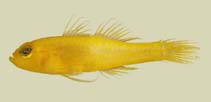| Family: |
Gobiidae (Gobies), subfamily: Gobiinae |
| Max. size: |
2.04 cm SL (male/unsexed); 1.97 cm SL (female) |
| Environment: |
reef-associated; marine; depth range 5 - 76 m |
| Distribution: |
Western Pacific: Fiji and Tonga. |
| Diagnosis: |
Dorsal spines (total): 7-7; Dorsal soft rays (total): 8-9; Anal spines: 1-1; Anal soft rays: 7-9. Diagnosis: Characterized by the presence of scales in the predorsal midline; second and third dorsal spines either slightly or not elongate; an unbranched fifth pelvic fin ray; both interorbital and postorbital trenches moderately well developed; and the absence of opercular scales. Scale margins of preserved specimens are very finely outlined with melanophores across the top half of the body, which is otherwise almost devoid of visible pigment cells. When alive, it has a yellow body, and the iris has a pair of blue and black triangles with their bases against the anterior and posterior margins of the pupil (giving the pupil a slit-like appearance), the posterior triangle continues anteroventrally around the pupil margin. Both living and preserved specimens have a dark basal stripe in the medial fins and a blaze of brown pigment on the upper part of the pectoral-fin base (Ref. 57544). |
| Biology: |
|
| IUCN Red List Status: |
Least Concern (LC); Date assessed: 07 September 2021 Ref. (130435)
|
| Threat to humans: |
harmless |
Source and more info: www.fishbase.org. For personal, classroom, and other internal use only. Not for publication.

